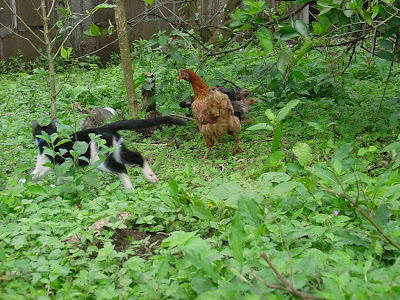GIVES A GREAT BATH!
?
What appears to be your common vining squash is oh-so-much more.?
I didn't believe it at first either.
Luffa sponge: in the tub.
Luffa squash? must be an unfortunate incident of coincidental nomenclature.
but no.
The luffa is widely renowned for its life post vine, after having matured into a fibrous seed pod, peeled, packaged, and marketed in your local pharmacy as an all-natural exfoliant.
Nobody talks much about the flavor, or the culinary uses of the reputed "sponge."
I am also elated to report, after devastating failures with zucchini and yellow squash, that luffa is a tropical plant! It LOVES the heavy rain! thrives on relentless sun! i'm talking a vining potential of 20 ft and fruit up to 2 ft long!
In mere weeks, my luffa seeds sprouted, grew several inches, flowered, and have now produced fruit!!!!!!!!!!!!!!!!!
Luffa connoisseurs recommend harvesting tiny 2'' long specimens in order to yield a tender, nutty flavor. As of today, i have only one developed squash, but i decided to give it a try as we are about to abandon the garden for a several week vacation. (By the time we return, i fear most squash will have become sponge-worthy!)
This is what i got:
Chopped, sauteed, and tossed in to my tortilla soup, I confess the elusive luffa evaded my taste buds. Hopefully in three weeks time there will still be delicate, edible squash to sample. if not, to scrub with?
Nobody talks much about the flavor, or the culinary uses of the reputed "sponge."
Luffa acutangula
In truth, luffa is also named Chinese okra, silk squash, and silk melon, amongst others and is a savored veggie in Asian cuisine.I am also elated to report, after devastating failures with zucchini and yellow squash, that luffa is a tropical plant! It LOVES the heavy rain! thrives on relentless sun! i'm talking a vining potential of 20 ft and fruit up to 2 ft long!
In mere weeks, my luffa seeds sprouted, grew several inches, flowered, and have now produced fruit!!!!!!!!!!!!!!!!!
Luffa connoisseurs recommend harvesting tiny 2'' long specimens in order to yield a tender, nutty flavor. As of today, i have only one developed squash, but i decided to give it a try as we are about to abandon the garden for a several week vacation. (By the time we return, i fear most squash will have become sponge-worthy!)
This is what i got:
Chopped, sauteed, and tossed in to my tortilla soup, I confess the elusive luffa evaded my taste buds. Hopefully in three weeks time there will still be delicate, edible squash to sample. if not, to scrub with?
Let them eat sponges!





































